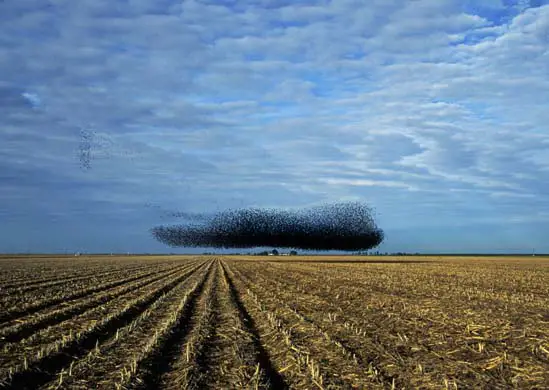(European starling checking out an empty nest box. Image courtesy of Birdzilla.)
Specifically, researchers in Western Australia used artificial nesting cavities to facilitate culling of common starlings (Sturnus vulgaris), an invasive species first introduced into Australia in the mid-19th century. Since that time, they've become increasingly widespread and problematic; the birds are currently held responsible for AU$300 million in crop damage each year. Because starlings are particularly choosy when it comes to nesting--reportedly even skipping breeding seasons rather than taking up residence in sub-par cavities--the researchers thought that they might be able to entice the birds into attractive artificial cavities from which both the adults and their offspring could easily be removed. Not only might this spare managers from searching for hard-to-find natural cavities, but it might also enable them to direct the starlings towards habitats that are particularly easy to access and navigate--namely, the plantation woodlots where the birds are already known to overwinter.
The first step of the study was to determine whether the birds would be interested in the artificial cavities to begin with, and, if so, whether they preferred a particular style and/or a particular type of breeding habitat. The researchers distributed a total of 180 artificial cavities across 3 types of habitat: 2 types of swamp (differing only in predominant tree species) and 1 type of plantation woodlot. The former 2 are the locations where the starlings currently breed, while the latter is where managers would like to attract them. The birds were given a choice of rectangular wooden nest boxes and terracotta pipes; both were positioned both horizontally and vertically. Boxes were checked on a monthly basis from May 2006 until June 2009, plus more frequently during the final breeding season; the authors managed a total of 5,580 observations over the course of the study. Although birds were banded and released during the first breeding season, they were culled thereafter. The researchers also performed habitat surveys aimed at measuring the abundance of natural cavities at each site.
(Cavity-loving European honeybees. Image courtesy of Wild About Britain.)
Unexpectedly, the starlings completely ignored the terracotta cavities and nested only in the wooden boxes. Even more unexpectedly, the boxes were also attractive to European honeybees (Apis mellifera), which occupied all but ~7% of the wooden cavities. Although the researchers smoked the bees out early in the study, the insects later reappeared and prevented starlings from using the boxes. To make matters worse, starlings were not found in the artificial cavities until at least 16 months after they had been installed; this likely resulted from the birds' neophobia, or fear of new objects. Only once the birds had acclimated to the sight of the new cavities did they dare venture inside.
Thanks to the honeybee occupation, starlings were not able to utilize nest boxes in any of the woodlots. Of the remaining two habitats, they clearly preferred swamps with dead trees. These sites contained approximately three times as many natural hollows as those with live trees; thus, the starlings' use of nest boxes in these habitats suggests that the birds find man-made cavities to be superior to their natural counterparts--a good sign for managers looking to attract the birds to particular places. During the first breeding season, the birds nested in 10 of 12 available boxes; during the second season, this number fell to only 5 boxes. Starlings are smart and have good memories, so this drop-off may reflect their active avoidance of artificial cavities after being manhandled there during the first season. Alternatively, these low numbers may simply reflect the birds' declining population throughout the study area.
(A flock of starlings; groups like these can decimate crops. Image courtesy of It's Nature.)
Despite the unanticipated setbacks associated with terracotta avoidance and honeybee occupancy, the researchers were still pleased with their results. Use of the nest boxes allowed them to remove anywhere from 45-87 adult birds from the population each year, along with a dozen eggs and a half-dozen nestlings. In all cases, they knew exactly where to look for the starlings and did not have to waste precious time or manpower searching for cryptic natural cavities. However, the authors were disappointed with their inability to draw starlings to woodlots, since these habitats would have facilitated even easier access to the birds. For those considering similar control efforts elsewhere, the researchers recommend deploying the nest boxes where natural cavities are not readily available, since these are the habitats in which the man-made cavities will look most attractive and, therefore, probably have the highest occupancy rates.
---
Note: I realize that this article discusses management techniques that some readers may find questionable or distasteful. For the record, this write-up does not necessarily reflect my own views on these management policies; I have merely tried to describe the original authors' methods, analysis, and conclusions as accurately as possible.
Campbell, S., Powell, C., Parr, R., Rose, K., Martin, G., and Woolnough, A. 2012. Can artificial nest-cavities be used as a management tool to assist the control of common starlings (Sturnus vulgaris)? Emu 112:255-260.



No comments:
Post a Comment